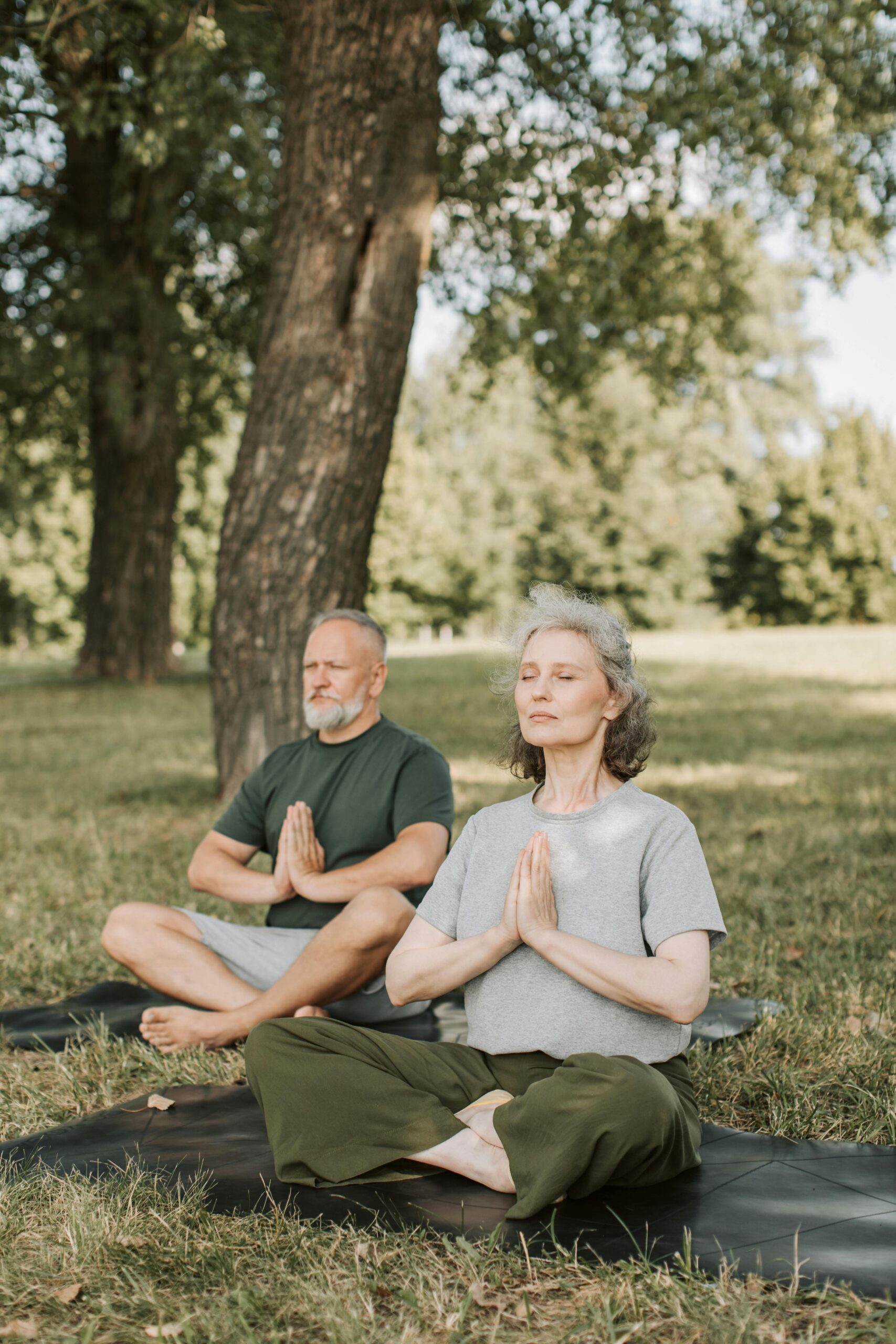5 Best Yoga Poses For Sleep: Reduce Stress And Anxiety

Stress and sleep usually go hand in hand for most people. Either you’re too stressed to sleep or you’re not getting enough sleep, which is making you stressed. Depending on how you handle your stress and anxiety, you could be sleeping anywhere from great to not even catching a wink. Not getting enough sleep can greatly affect your health. A lack of sleep can lead to obesity and impaired cognition as we age. There’s a lot at stake when we don’t get enough sleep. Yoga has the potential to help us sleep better while also reducing our stress and anxiety.
We live in a fast-paced environment, where our minds are constantly being stimulated. This ongoing state of hyper-stimulation makes us potentially more on-edge, in the very same way that an over-stimulated baby is usually fussy and unable to fall asleep. We’re all big babies when it comes down to it. If you already practice yoga, you know that it offers so many more benefits than just core strength and flexibility. Practicing yoga regularly could help with your sleep and anxiety, you just need to know the correct way to do it.
Can Yoga Improve Sleep? Yoga To Help Sleep Explained

Yoga may improve quality and quantity of sleep.
You know how yoga makes you feel, but did you also know that it can improve your sleep? Practicing this ancient method may even be able to help those who suffer from insomnia. Research has shown that yoga helps people who have insomnia by allowing them to fall asleep quicker, sleep longer, and fall back asleep faster if they wake up in the middle of the night. It’s even able to help older people with insomnia. It’s shown to be extremely beneficial for people over the age of 60. It doesn’t just stop at insomnia. Pregnant people usually have trouble sleeping because of their changing body, but if they start practicing yoga in their second trimester, it could help them have better quality and quantity of sleep. Since many medical patients experience insomnia during treatment, yoga can help them as well.
Even though there isn’t much research on how yoga affects one’s sleep, there’s no harm in trying it. It clearly has worked for some and could very well work for you. Yoga calms the mind and therefore relieves tension in the body which helps you fall asleep. Instead of taking sleeping pills, you may want to try yoga as an effective natural sleep remedy. Taking a yoga class at night may even help you sleep better and fall asleep faster.
Yoga For Managing Stress And Anxiety

Yoga for reduced stress and increased sleep.
Loss of sleep is a major cause of stress in the United States. Using meditation and other techniques to reduce stress has been studied since the 1970s. They’ve been studied as possible treatments for anxiety and stress. Yoga classes vary greatly. They can be gentle for beginners or strenuous and challenging for people who are looking to burn more calories. The most commonly practiced yoga is called Hatha yoga. It is a combination of poses, controlled breathing exercises, and meditation. Yoga can function like other techniques that are meant to self-soothe.
There was a small study done at the University of Utah that was able to give insight on how yoga affects the stress response. They looked at the participants’ responses to pain to see how practicing yoga affected the pain response. It was revealed that the experience yogis had a higher pain tolerance than people who didn’t practice yoga. Therefore, yoga can help regulate stress levels since it has an effect on pain responses. There are many forms of yoga that are safe for most people, but there are also strenuous types that shouldn’t be practiced by all. If you’re dealing with stress and anxiety, taking up yoga may be a great option to manage your symptoms.
5 Best Yoga Poses For Sleep Breakdown

Our top 5 favorite yoga poses.
1. Hero Pose
Hero pose is important because it’s the foundation of many other poses. It’s crucial for you to be comfortable, sitting with heels under your glutes. The tops of your feet should be on the floor. Sitting like this, in hero pose, will stretch your knees and ankles. Stretching these areas will hopefully protect them against injury. If your knees or ankles crack a lot, this should help prevent that while also making them feel warmer and more comfortable. Sitting in this position, lengthen your spine upwards and open your chest while breathing calmly. You should be able to clear your mind as you focus on your slow breathing patterns. It’s a very relaxing pose when done correctly.
2. Figure Four Against The Wall
If you’re looking for a great way to stretch your hips before you go to sleep, then this is the pose to try. All you need is a wall or something tall and sturdy. Lay on the floor, on your back. Your glutes should be about a foot away from the wall. The bottom of one of your feet should be placed on the wall. Make sure that your tailbone stays flat on the floor. The opposite foot should be flexed and placed on top of the opposite thigh. Keep the foot flexed since it protects your knee from injury. There are ways to intensify this stretch, but this should be good for now. You should switch sides whenever you’re ready. Stretching your hips before you go to sleep will help you feel more comfortable.
3. Child’s Pose
To begin many poses, you need to start with the tabletop pose, which is exactly how it sounds. It’s when you’re on your hands and knees with your hips squared with your shoulders and your back in flat. From the tabletop pose, you can sink your hips back to your heels. Rest your chest between your thighs. Your big toes should be touching one another and your knees are far apart but to your comfort. Let your forehead rest on the mat or blanket that you’re lying on and walk your fingertips out in front of you while fully stretching your arms. This is very relaxing you may even fall asleep.
4. Reclining Goddess Pose
Starting from lying on your back with your knees up and feet together, slowly drop your knees to the side, allowing the bottoms of your feet to touch each other. Pull your heels as close to your pelvis as is comfortable. This simple move stretches out the inner thighs, lower abdomen, and pelvis. You can pull your shoulder blades underneath you by making a larger space between your earlobes and the tops of your shoulders. Let your left hand rest on your heart and your right hand on your abdomen. Close your eyes and relax your face as you feel your heartbeat and breaths.
5. Cat And Cow Pose
You may know it as the Cat and Cow Pose, but it’s also known as “Marjaryasana and Bitilasana.”To begin this pose, you’re going to want to start in Hero Pose and roll forward onto your hands and knees. While in the cat pose, you exhale as you slowly drop your head towards the floor while arching your back so your tailbone is facing the floor. Pull your shoulder blades apart as you curve your spine into a C. You can then inhale into the Cow pose by bringing your face and tailbone up while letting your back curve inward. You can go between these two poses for however long you want. This helps loosen up your spine.
Yoga Nidra Sleep Meditation Explained
For all of you that may not know, Yoga Nidra is sleep meditation. They are one and the same. Even though Yoga Nidra and plain old normal sleep may sound like the same thing, they aren’t quite. One of the key differences is that during sleep, our subconscious takes over – which is why we sometimes have some wild dreams – but during Yoga Nidra our conscious mind is awake. While we are sleeping, our subconscious mind is unable to leave our stresses and worries, but during Yoga Nidra, it can. It becomes similar to sleep therapy.
Practicing Yoga Nidra is easier than you would think. You can use a guided audio track that’s usually 40-45 minutes long. As you slowly relax every part of your body, you should focus on your breathing and happy memories. Hopefully, by the end of the session, you’ll feel some relief from any stress or worries that were weighing you down. Even though sleep meditation is not a substitute for sleep, it can help increase the quality of sleep if practiced correctly. Many even say that a 45-minute session of Yoga Nidra feels like 3 hours of sleep. Feeling and being well-rested is life-changing.
Conclusion
Stress and sleep go hand in hand. If you’ve got stress, you’re usually lacking in sleep and if you’re lacking in sleep, you’re usually stressed. All of us have some level of stress, but we need to find the right way to deal with it. Anxiety and stress can affect your well-being, mind, and body. It’s not okay to constantly be flooded by bad thoughts. They can be taxing and lower your quality of life. So the next time you’re looking for a way to de-stress and unwind, consider practicing some yoga. You may want to turn to medications, but it’s also healthier and safer to use natural remedies. You should speak to your doctor if you are having distressing or disturbing thoughts.
Whether you’re an expert or a beginner, there’s a yoga pose for you. Yoga is meant to relax the body and mind, which is why it’s great for helping you fight insomnia and depression. The term yoga means unite which makes sense since yoga is the practice that unites mind, body, and spirit. While you’re increasing your strength and flexibility, you can also be renewing your mind body and soul. A better night’s sleep is quickly approaching.

